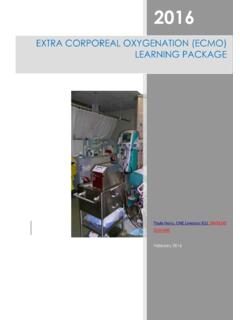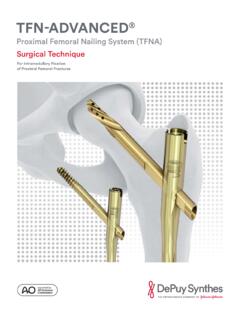Transcription of Maintenance and Removal of Central Venous Catheters
1 1 Maintenance and Removal of Central Venous CathetersPresenterKaren Jones, RN, MPH, CICC linical Research Project CoordinatorUniversity of MichiganContributions byVineet Chopra, MD, MSc University of MichiganKristi Felix, RN, BSN, CRRN, CIC, FAPICM adonna Rehabilitation HospitalLen Mermel, DO, ScM, AM (Hon)Medical School of Brown UniversityRuss Olmsted, MPH, CIC, FAPICT rinity Health, Livonia MIPayal Patel, MD, MPHU niversity of Michigan2 Learning Objectives Discuss components of the Central Venous catheter (CVC) Maintenance bundle Outline issues to address during the transition of care of a patient with a CVC Describe strategies to promote the Removal of unnecessary CVCs3 Impact of Infection CLABSIs result in increased mortality and health care costs Of all healthcare-associated infections, CLABSIs cause the highest number of preventable deaths 65% 70% of CLABSIs can be prevented by implementing evidence-based practices 4(APIC Implementation Guide.)
2 Guide to Preventing Central Line-Associated Bloodstream Infections, APIC, 2015)Targeting Maintenance and RemovalStandardize CVC Maintenance care where possibleMaintain awareness of CVCs that are in placeRemove CVC when no longer necessary5(MeddingsJ, Saint S. Disrupting the life cycle of the urinary catheter. ClinInfect Dis. 2011;52(11):1291-3. PMID: 21596672)Case Study: MaintenanceMrs. Smith is admitted to the ICU following a motorcycle accident Traumatic brain injury Compound open fracture of femur, rib fractures Requires mechanical ventilationHas an internal jugular CVC for hemodynamic support and antibiotic : What are the CVC Maintenance priorities for this patient?
3 6 Disclaimer: All case studies are hypothetical and not based on any actual patient information. Any similarity between a case study and actual patient experience is purely Bundle of CareConduct daily assessments of the necessity of CVCs, with prompt Removal if no longer neededAccess ports of entry with aseptic techniquePerform proper care of infusion tubing Assess and care for Central Venous catheter dressings 7(Checklist for Prevention of Central Line Associate Blood Stream Infections, CDC, 2011)Basics to Consider8(Marschall J, Infect Control Hosp Epidemiol, 2014)Daily Assessment of NecessityAssess necessity of CVC daily with a multidisciplinary teamIndications for ongoing use can include: Clinical instability of the patient Prescribed continuous or intermittent infusion therapy Hemodynamic monitoring Documented history of difficult peripheral Venous accessUse tools like electronic medical record reminders, daily rounding forms or checklists to prompt discussion among staff and leaders9(Gorski L, J Infus Nurs, 2016)Example of CVC Necessity Tracking ToolReview Daily with Physician for Central Line Necessity Tracking ToolPatient Name.
4 _____Room # _____MR # _____Central Line Insertion Date: _____D/C Central Line Date: _____DateTime(check once per day)Necessity of Central Line ReviewedIndication for Central Line Use/ Continued Use(see list below)If no longer indicated, is there a plan to remove Central Line?RN SignatureYes NoYes No N/AYes NoYes No N/AYes NoYes No N/AYes NoYes No N/AYes NoYes No N/AYes NoYes No N/AYes NoYes No N/AYes NoYes No N/AINDICATIONS FOR Central LINE USE/CONTINUED USE: (List all that apply)1. Prolonged IV therapya. Antibioticsb. Total parenteral nutritionc. Chemotherapy2. Irritating medications3. Poor peripheral Venous accessComment: Blood sampling is not indication for a Central line unless there is poor peripheral Venous access4.
5 Critical illness requiring Central Venous accessa. Hemodynamic monitoringb. Vasoactive drips5. Hemodialysis or plasmapheresisModified from IPRO's "Review Daily With Physician for Foley Catheter Necessity" Tracking (Used with permission: New York State Partnership for Patients and IPRO. Review Daily with Physician for Central Line Necessity Tracking Tool [NYSPP], adapted from Review Daily With Physician for Foley Catheter Necessity Tracking Tool [IRPO]. Accessed [date] at Proper access of CVCA ccess CVC only with sterile devices Scrub the hub vigorously for at least 5 seconds with an appropriate antiseptic and allow to dry prior to every accessAssess patency of lines by flushing and aspirating for blood returnMinimize the interruptions of the CVC Maintain a closed system as much as possible Minimize frequency of tubing disconnects and flushing11(Gorski L, J Infus Nurs 2016; Marschall J, Infect Control Hosp Epidemiol, 2014.))
6 O Grady NP, Am J Infect Control, 2011)CVC Infusion TubingReplace administration sets not used for blood, blood products or lipids at intervals of no more frequently than every 96 hours but at least seven days Includes secondary piggyback sets attached to primary continuous set if it remains connectedReplace tubing used to administer Propofolinfusions every 6 or 12 hours, per the manufacturers recommendations or when the container is changedChange needleless components at least as frequently as the administration set There is no benefit to changing these more frequently than every 72 hours12(Gorski L, J Infus Nurs 2016.
7 O Grady NP, Am J Infect Control, 2011)CVC Dressing ChangeAssess dressing status at least dailyReplace dressing: Every 2 days for gauze dressings Every 7 days for transparent dressings And whenever dressing becomes damp, loosened or soiledUse aseptic technique and prepare clean skin with greater than chlorhexidine with alcohol 13(O Grady NP, Am J Infect Control, 2011)CVC Dressing Change (Continued)Document date and time on dressing Do not disturb or change a clean, dry, intact dressing until the due date14 Case Study: Transfer of CareTracheotomy placed for continuous ventilator supportNeurological status remains poorDiagnosed with osteomyelitisPeripherally inserted Central catheter (PICC line) placed for long-term course of antibioticsMrs.
8 Smith to be transferred to LTACHQ uestion: What aspects of care coordination for the Central line need to be addressed upon transfer?15 Disclaimer: All case studies are hypothetical and not based on any actual patient information. Any similarity between a case study and actual patient experience is purely Coordination of Central LineKey details to communicate: Initial indication for CVC If for antibiotics, the date they were started and reason for treatment Date that the line was placed Date that the dressing and tubing were last changed Issues with patency of lumensOngoing assessment of necessity should occur in the new care setting16 Disclaimer: All case studies are hypothetical and not based on any actual patient information.
9 Any similarity between a case study and actual patient experience is purely Study: Removal of LineDay 28: Mrs. Smith is improving and breathing on her own and she is hemodynamically stableAntibiotic course is completed and the infection has resolvedShe is scheduled for routine lab tests every two daysQuestion: Does Mrs. Smith need to continue to have a PICC line in place? Can the line be removed?17 Disclaimer: All case studies are hypothetical and not based on any actual patient information. Any similarity between a case study and actual patient experience is purely : A Bundle ElementMichigan Keystone ProjectDecrease in CLABSIs in 103 ICUs in Michigan (66% reduction) Hand hygiene Full barrier precautions during Central line insertion Skin cleansing with chlorhexidine Avoiding femoral site Removing unnecessary Catheters Use of insertion checklist18(Pronovost P, N Engl J Med, 2006)MAGIC Criteria for Ongoing PICC UseAppropriate Indications for PICC useDelivery of peripherally compatible infusates when the proposed duration of such use is 6 daysDelivery of non-peripherally compatible infusates ( , irritants or vesicants)
10 , regardless of proposed duration of useDelivery of cyclical or episodic chemotherapy that can be administered through a peripheral vein in patients with active cancer, provided that the proposed duration of such treatment is 3 monthsInvasive hemodynamic monitoring or requirement to obtain Central Venous access in a critically ill patient, provided the proposed duration of such use is 15 daysFrequent phlebotomy (every 8 hours) in a hospitalized patient, provided that the proposed duration of such use is 6 daysIntermittent infusions or infrequent phlebotomy in patients with poor/difficult peripheral Venous access , provided that the proposed duration of such use is 6 daysFor infusions or palliative treatment during end-of-life careDelivery of peripherally compatible infusates for patients residing in skilled nursing facilities or transitioning from hospital to home, provided that the proposed duration of such use is 15 days19(Chopra V, Ann Intern Med, 2015)













